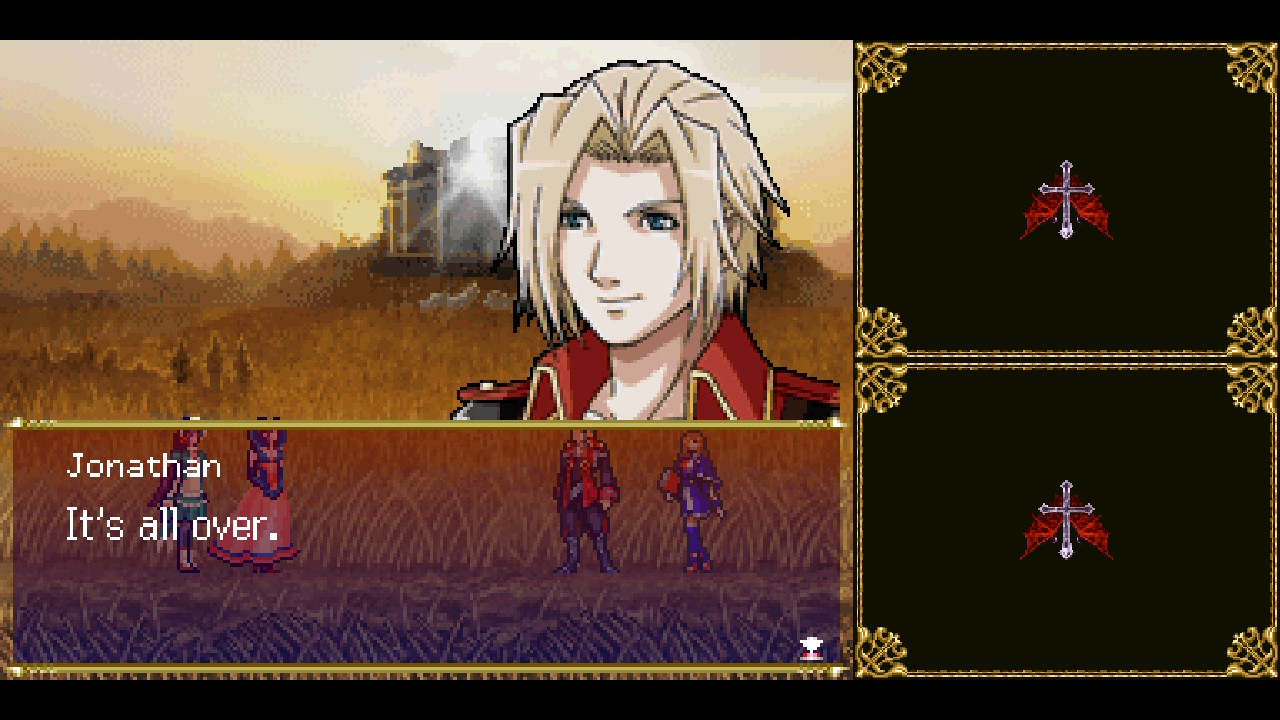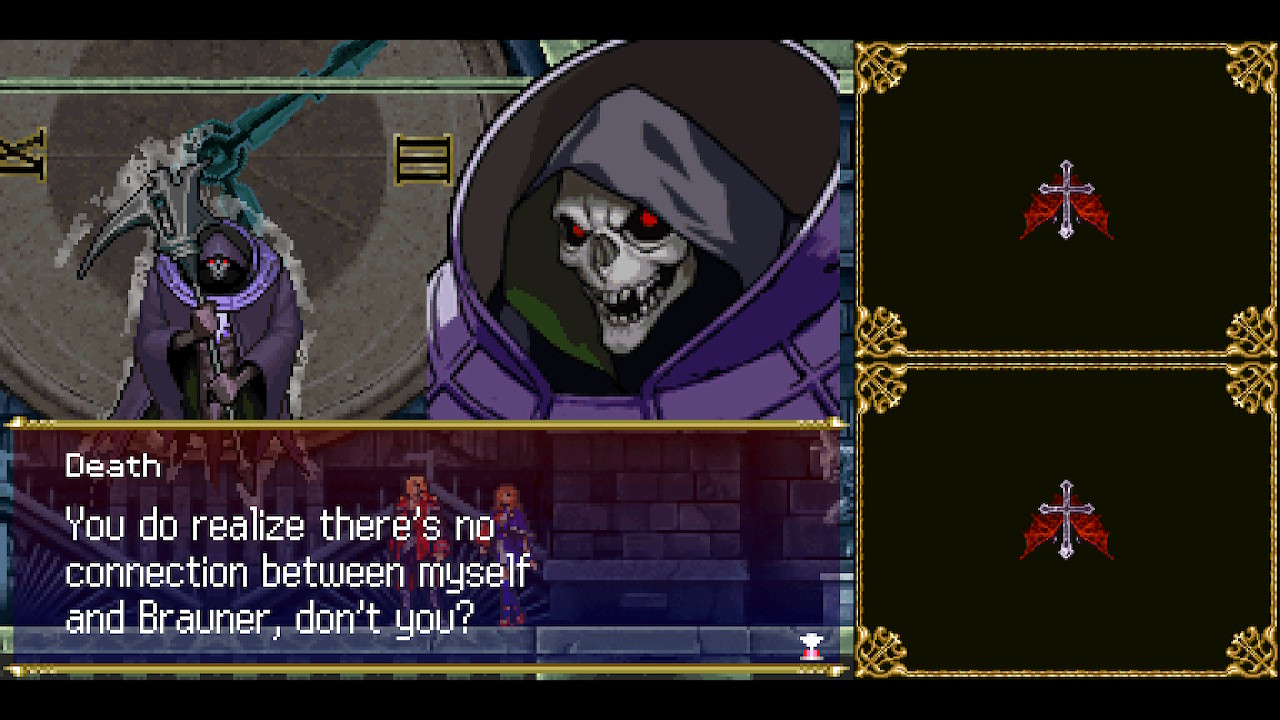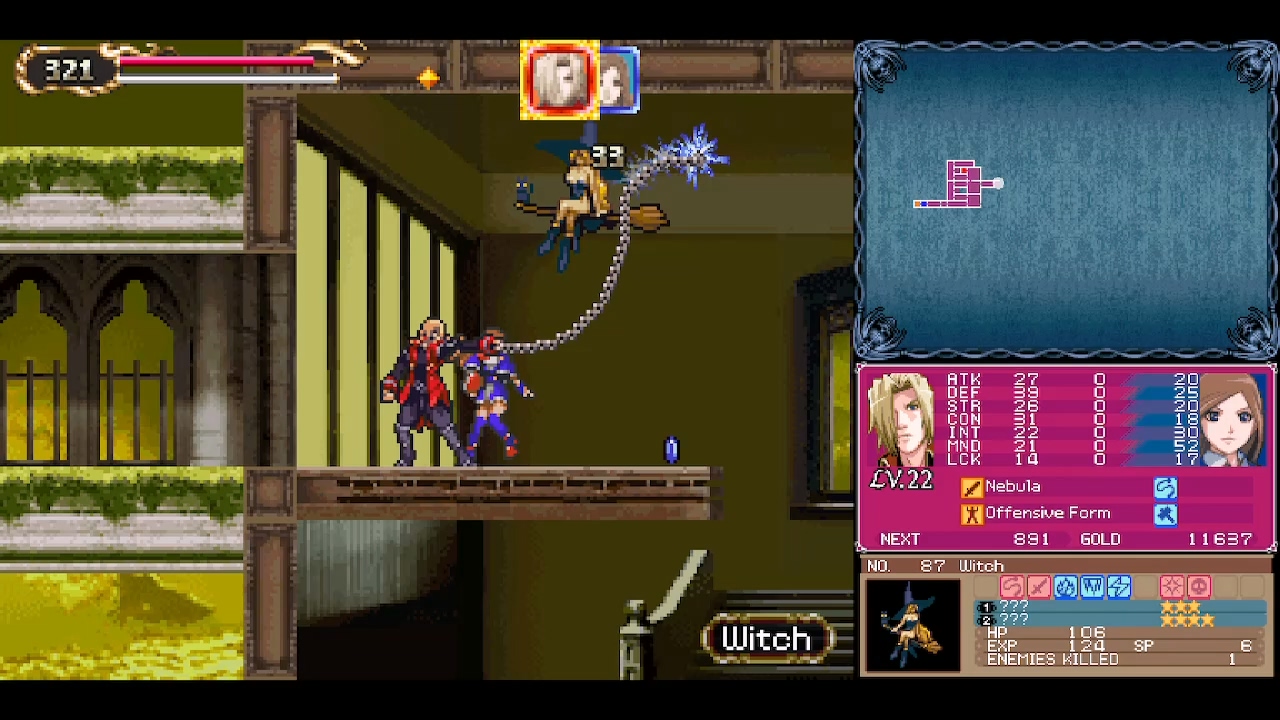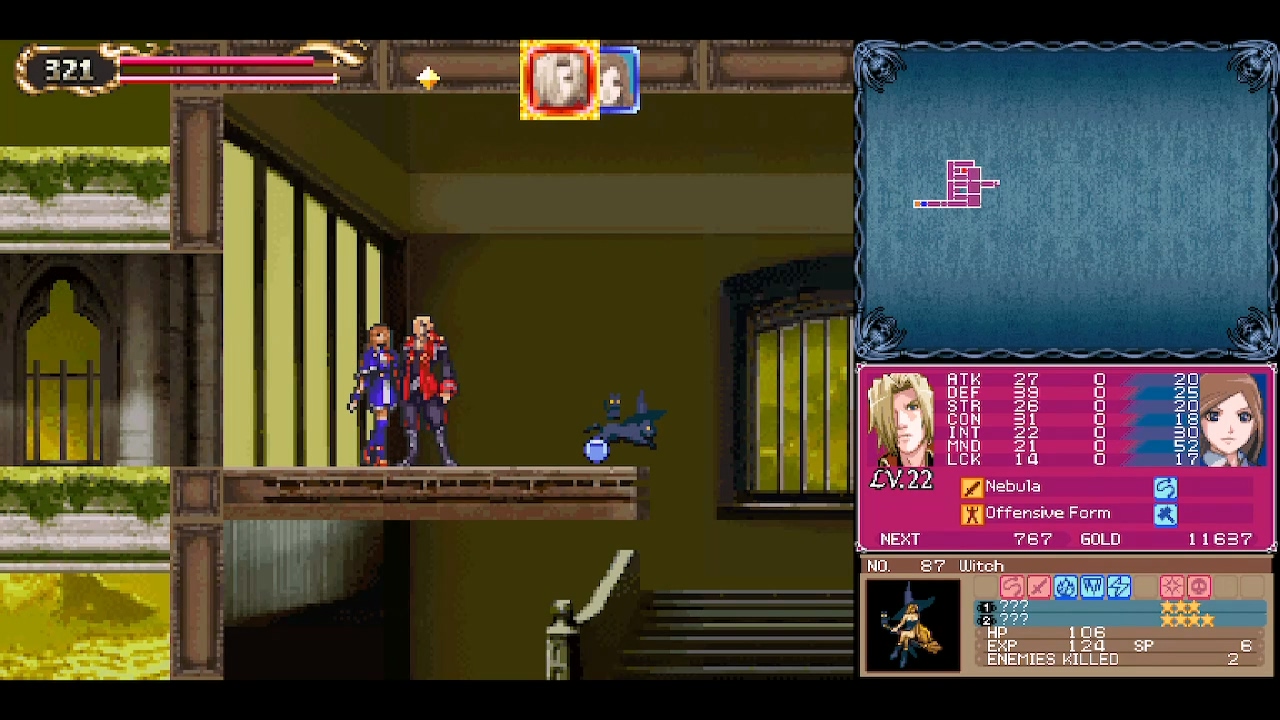I gave Circle of the Moon another try on Castlevania Advance Collection.
It’s still a bad game. Had to rewatch the intro multiple times, with no option to skip it, since the very first save point is placed badly, and I died multiple times looking for it.
The level design is obnoxious, with those “wells” that you have to jump from platform to platform, instead of a more serpentine multi-floor designs of some of the later installements. What puzzles me, though, is that the earlier Symphony of the Night got the design right, though!
Then there’s the drop rate… The main feature of the game is that you can combine two types of cards in order to imbue your whip with different powers, which gives you about 64 different options. Sounds great! And the nice thing about the Advance Collection version is that there’s an indicator if an enemy can drop the card, and if you already have it or not. But I spent probably half an hour farming for a very basic card, killing axe armor maybe 100 times, and I still haven’t got it. You know what, this simply doesn’t worth it.
Tag: Castlevania
Completed Portrait of Ruin.

I usually prefer two handed swords in Castlevania games for their reach, overhead pattern and damage. But in this installment I ended up using Heaven Sword most of the game, switching to Flame Whip and Vampire Slayer at later stages.
After beating the four paintings, you just have a set of bosses left. First, there’s optional Memory of the Whip, which is Richter from Super Castlevania. He can kill you in 5-6 hits, his whip is super quick and has a very good range. I ended up stocking on potions and just kiting him at a range. He basically runs into your weapon, and then you can backdash. With his whip, I just overpowered Brauner, not messing with all his painting magic. It’s impressive technologically how he draws a pattern on a canvas, then the same pattern covers the screen damaging you, but I don’t have patience for this shit.
Then there’s the Dracula and Death duo. Honestly, I think that’s one of the thoughtests bosses I had to face in Castlevania games. Death hovers above Dracula making it difficult to jump over him, hits you while you try to dodge the usual fireballs, can be hit only in double jump, and generally, a pain in the ass. Then there are some Dracula attacks that simply one-shot you.
I’m not sure if it’s the necessity of double jumps, or just the intensity of this fight, but I felt that the controls were very sluggish, like there’s a lag every time I press a button. Maybe it’s the Dominus Collection, or just me. At least the game itself didn’t lag, like the Order of Eclessia when I played it on the original console.
Or maybe the developers intended that you’d attempt this fight only after finishing all the quests. But with the quests such as “kill 1500 enemies with the Javelin skill”, no, thank you very much.
If it wasn’t for the two inverted paintings, and the frustrating final fight, I’d say the game was fantastic. But all in all – I’m not sure.
Of course there’s a False Ending, it’s Castlevania after all. Path to the True Ending in this game is slightly more obvious than in others, though. Or maybe I just played enough Castlevania’s by this point.
First, you obtain the spell the cures vampirism, and you even get to practice it on the monk shopkeeper. And then during battle with Loretta and her sister, you just distract them long enough to cast it.
I also beat them to get the False Ending. They aren’t hard. Funny thing is, the spell is called “Sanctuary”, so it’s not very obvious from its name that it cures vampirism. And I picked it up completely by chance, not evening remembering where.
By that time, I think developers ran out of budget, since they just dump 4 paintings (portals) on you, go and clear those, then come back.
Death boss was the first that gave me a real pause. The spinning scythe homes on you, and the horizontal swipe has a lead: if Death starts telegraphing and you jump, it still can follow you and hit in mid air. It’s also not very clear what the boss is resistant to when it switches colors. But by wasting a few potions, I managed to beat it.

I forgot how much I love the witches design in Castlevania. The fact that there’s a cat familiar sitting on her broom, and then when she’s defeated, she turns into a cat with a witch hat, with the familiar still sitting on her back. So much detail and love.
I tried to play it many years ago, I think still on original NDS.
The two character mechanic is fun. Second character can take out the smaller annoying enemies or cast spells as you fight.
What I didn’t remember is that the game was leaning heavily into 3D backgrounds. Or maybe I simply didn’t notice on the tiny screen.
The theme of this game is paintings. So besides the usual Dracula Castle, we also have painted worlds we enter, each the size of castle itself. There is European city, Egypt, and so on.
I was enjoying the game until Nation of Fools painting. Castlevania can get quite confusing by itself. With the world at 90 degrees, it becomes simply annoying.
Legion, the ball of bodies, makes a comeback. Waste not, want not. It was giving me a lot of trouble until I discovered Heaven’s sword that wasted it in seconds.
Stella was also lots of trouble for me in her second phase, until I got the Nebula whip that, unlike most whips is Castlevania, actually aims.
Also, I just love this entrance sequence:
Castlevania Dominus Collection released on Steam and Nintendo Switch is one less reason for me to own NDS/3DS now. Until recently, Dawn of Sorrow, Portrait of Ruin and Order of Ecclesia were all NDS exclusive. I even finished Order of Ecclesia a few years ago on 3DS. Now I’m sorry I haven’t waited for this release, as playing NDS games is often a pain: you can’t take screenshots, and the game also hung up on me a few times.
In any case, this is another chance for me to try and finish Portrait of Ruin.
Completed Castlevania: Order of Ecclesia.
Took me almost 4 months, albeit with pauses. Started to play it in March, and completed it just now.
Decided to play this game after completing Bloodstained: Ritual of the Night. It was a mistake to try in play it on the original hardware, though. First, NDS can’t take screenshots. The game is gorgeous, but I can’t prove that now. Second, there are considerable slowdowns when there are a lot of moving objects on screen, which make some boss battles frustrating.
But first things first.
Bloodstained’s heroine was an exact copy of Shanoa, heroine of the Order of Ecclesia. Up to color of her dress and the tattoo on her back.
There’s no difference between weapons and spells now, or as they called here glyphs. A rapier, called Confodere, or a hammer, called Macir, use the same mana as a lightning bolt. Mana recovers quickly after a brief rest, very similar to endurance in Dark Souls series.
Different from most other Castlevania series, instead of a huge castle, there are a lot of discrete locations. All of them are rather small, and some of them also quite linear, even corridor-like.
In terms of pixelart, this is the swan song of NDS. The next Castlevania game will be already a 3D one. And Prison Island is simply a muscle flex, with it’s hand drawn lighting and shadow effects.
In terms of combat system, at a certain point I felt that they should have called it “Order of the Axe”. Seriously, Axe glyph rules the midgame. I always found axes in Castlevania games awkward. But in Order of Ecclesia they simply… work? You can hit enemies above or below you, which is great. You can also hit bosses multiple times, because their sprites are so big. Guess the game also helps you a bit in aiming your throws.
Crab boss was easy, except for the slingshot parts. You need to drag your character down in order to go up the Lighthouse. But then the boss is also beneath you. If you fall, you touch it. One touch, and you’re basically dead, caught in a damage loop.
Maneater boss was a lot of trouble for me due to its random moving patterns, and a lot of flying debris causing lots of damage. Then I discovered I have missed the light magic, Luminatio, at the top of the Lighthouse. I actually went all the way up, but then the elevator glitched, and went all the way down, so I assumed you need to do something special in order to fix it. Turns out it works just fine on the second try. And by mashing double light magic, the Maneater boss went down on my first try.
Not sure if I’ve “got” the game after that, but I enjoyed Russalka, Goliath and the “sand shark” bosses immensely.
I also feel that the game is slightly easier than other Castlevania games. A lot of glyphs have a rather wide arc, so you don’t have to position yourself that much. You can hit enemies standing above or below them, out of their reach. Unlike Symphony of the Night, where you had to get “in their face” all the time. And there are even some homing glyphs.
Also, the good ending is slightly more obvious than in some other Castlevanias, as I have missed just two villagers in my first attempt, and I was doing that without a guide.
Barlowe was a huge pain for me. Lots of well timed jumps, especially in his second phase, when he starts to dash at you. Fail any of the five jumps, and you’ll be stunlocked, and probably loose around 50% of your total health. Ended up stocking on healing potions, just to get past him.
The next boss, Wallman, is a clever reference to Konami’s own Bomberman, by the way.
I really hate when others say “you haven’t seen the game until you do X”, but in case of Eclessia, it is quite true. You haven’t seen the true Castlevania until your reached the castle. And you reach the castle only if you head for the true ending.
Blackmore boss’ design is absolutely awesome: evolution of “not shadow effect” we’ve seen back on Prison Island. But the necessity of constantly staying in the air was quite tiring. I wish I didn’t play this part on the original console.
Eligor was a pain in the ass for me for a few evenings. I almost dropped the game at that point. It’s a long fight with four phases. The boss is huge, but with only a few vulnerable points that are hard to reach. What changed the fight completely for me was the Melio Ascia glyph (throwing axe). It drops very rarely, so I had to farm for 30 minutes for it. But once I’ve got it, destroying centaur’s crossbows is a breeze.
I literally cheated death by cheating the Death boss with the Death ring. Sorry, not sorry. That ring doubles your damage, but you die from a single hit. Unless you unequip it in time…
Final boss, Dracula was super annoying. He hits hard, and his patterns are very hard to avoid, compared to any other boss in the game. I tried to soak damage using the best shield, but the slowdowns in this fight are so bad and he hits so hard I still couldn’t beat him for a few evenings. Had to farm for an hour to level up and get tons of gold. And then used the same trick as in Bloodstained: stocked food items. All the food items I could get. That did the trick. Glad it’s not Hollow Knight!
Going back to pixelart for the last time: Dracula’s cloak is simply mindblowing.
Mirror of Fate HD
Прошел Mirror of Fate.
За Alucard’а играть на порядок сложней, поскольку его скиллы – полное дно. Mist form восстанавливает жизни через раз. Wolf form не то, чтобы бьет значительно сильней. Стая летучих мышей на боссов не действует. Только замедление еще хоть как-то помогает.
Третья глава – за Trevor’а, который после перерождения стал Alucard’ом. Он по стилю больше всего похож на Gabriel’я из первого Lords of Shadow. Та же система Light/Shadow magic.
Mirror of Fate HD
На первых порах у Саймона есть лишь одна магическая способность – неуязвимость. Фактически, использование маны вместо HP. Выглядит как женский призрак в плаще, блокирующий удары. Каково же было мое удивление, когда второй босс, Necromancer, заявил что-то вроде “You hide behind a woman!” и эту способность отобрал.
Вторая акт играем за Alucard’а, который только что вылез из склепа. Непонятно почему, но у него ровно та же экспа, что и у Саймона, хотя проходит второй акт параллельно с началом первого. И это после того как несуразность со свитками, которые нужно собирать с тел воинов, старательно объясняют. Не то, что все воины были страшными любителями вести дневнички. Просто это магические свитки, записывающие последние мысли владельца. Хотя наверняка будь это так, большая часть из них завершалась бы “Ебааать…”.
Mirror of Fate HD
Играем за Саймона Белмонта, внука Дракулы. Он вооружен простым хлыстом, а так же одет как заправский метросексуал в какой-то кафтан с открытой грудью и меховым воротником.
С одной стороны, боевую систему оставили из Lords of Shadow. Сильный прямой удар, слабый удар по округе. С другой стороны, игра все же двумерная, так что простора для откатов тут все же сильно меньше.
Картинка хоть и cильно за’celshade’диная, но приятная. А вот с анимацией все очень грустно.
О счастье, наконец-то на карте можно оставлять пометки! Им взяло всего то двадцать лет, чтобы додуматься, что в игре, целиком и полностью построенной на бэктрекинге порой нужно оставлять пометки на карте.
Lords of Shadow 2
Прошел Lords of Shadow 2.
Внезапно, для игры которая была целиком и полностью посвящена битью демонов по ебалу, к финалу открывается многоходовая комбинация Габриэля и Тревора, более известных как Дракула и Алукард. Последний, кстати, до боли похож на позднего Рейдена из Metal Gear Solid.
Lords of Shadow 2
Новые приемы приобретаются за выбиваемый из противников и прочих бочек опыт, но вот прокачивается оружие как раз по мере использования.
Эпизод с поездом – почти Uncharted. А эпизод в театре, где нужно подстраивать декорации под повествование – это же Shadows of the Damned.
Сюжет – это конечно какой-то наркоманский бред. То и дело выпадаем в прошлое, которое вроде как и не прошлое, где нужно то сосать кровь у своей жены, то отправляться за Mirror of Fate для своего сына, просто потому, что он так попросил.
Непонятно зачем вставили так же несколько stealth эпизодов, где нужно прятаться от “охотника”. То от вампирши с фонарем, то от брата фавна из первой части.
Встречаем Victor’а, последнего из Belmont’ов. В нем забавно то, что дерется он в стиле Габриэля из оригинала, и пользуется тем же крестом-хлыстом. Бегать с ним правда доводится не долго, он довольно быстро подставляется.
Lords of Shadow 2
Игра быть может приобрела в разнообразии, но явно лишилась цельности. Тут тебе и замки из оригинала, и техногенные демоны из последнего Devil May Cry, и аналог Ада, где только Данте и не хватает. Ситуации в общем-то схожа с серией The Darkness, вторая часть которой сделали красочней, но бестолковей.
Схватка с трехглавой горгоной (да, это не ошибка) хорошая, но до неприличного сильно напоминает схватку с гидрой из первого God of War. Хотя за финал схватки конечно многое можно простить. Эффект с драконом-рукой, которым герой добивает гидру-горгону, это, кстати, вылитая Bayonetta.
Вообще непонятно, почему Габриэль видит призрак своего сына. Его сын умер взрослым мужчиной, а затем вообще стал вампиром.
Lords of Shadow 2
Вступление крайне пафосное, и золотым ангелом-паладином больше всего напоминает Bayonetta.
После вступления идет краткий, всего то на несколько минут, пересказ “предыдущих частей”. Сначала Бельмонт-дед собственно стал Дракулой. Затем Бельмонт-сын попытался его убить, погиб, стал вампиром. И наконец Бельмонт-внук при поддержке Бельмонта-сына убил Бельмонта-деда. Такая вот семейная драма.
Как выясняется, убили они его не окончательно. Впрочем, это показывали еще в финале Lords of Shadow. По контрасту со вступлением, дракула-старик разгуливает по современному городу завернувшись в какую-то занавеску.
Castlevania: Lords of Shadow на PC
Вот и Lords of Shadow почтит своим вниманием пекашечку. Конец поколения, все дела. Я ее прошел на Xbox’е, но вдруг кто-то еще не.
Portrait of Ruin
По стилю Джонатан очень схож с Сомой. Тот же арсенал, плюс хлыст. Последний судя по всему можно апгрейдить, но пока что он весьма бесполезен. В особенности по сравнению с двуручником, который по прежнему решает.
Еще одно отличие, пусть и не столь значительное – у Джонатана нет защитных скиллов. В роли защитного скилла может выступать скилл напарника. А собственные атакующие скиллы представляют из себя пока что различное метательное оружие. Вполне логично, что вся элементальная часть ложится на плечи магини. Удобно, что напарника можно вызывать только для поддержки. Он исчезает сразу после применения скилла, таким образом не тратя ману понапрасну.
Новая механика – комбы. По сути, они представляют собой мощный заклинания, и так же расходуют ману. Даже базовое комбо, в котором Джонатан и магиня просто поочередно наносят несколько ударов выглядит весьма зрелищно.
Portrait of Ruin
По первым впечатлениям – взяли Julius Mode и сделали из него полноценную игру.
Если два персонажа – Jonathan и Charlotte. Jonathan даже хлыстом по началу пользуется, как и Julius. Между двумя персонажами можно свободно переключаться в любой момент.
Головоломки построены на совместных действиях. Оставляем одного персонажа на платформе, вторым подвигаем платформу, переключаемся на первого и используем нужный рычаг. Двойного прыжка нет, зато есть прыжок по голове напарника, действующий схожим образом.
Напарник или вызывается только для специальных атак, или же бегает за основным героем, повторяя все его действия. Единственную вольность, которую он себе позволяет – это атаковать близко подошедших монстров.
В игре есть квесты. Пока что их дает только синий призрак. Квесты в духе “отправься к мяснику за фаршем и получи новый прием”. Естественно, еще нужно понять, где находится мясник, и как из него выбить необходимый фарш.
Symphony of the Night
Мне помнилось, что в Symphony of the Night графика намного лучше сиквелов на NDS. Оказалось, что это не совсем так. Спрайты во многом схожие. Где-то лучше, где-то хуже. Трехмерная часовня на фоне луны перекочевала и в Dawn of Sorrow. Вот в чем SotN беспорно выигрывает, так это в эффектах. Черная дыра на фоне сражения с Дракулой – на две головы выше невнятного фона во время сражения с Menace’ом.
Что старого в механике. Вместо клавишь удар-суперудар две клавиши соответствующие двум рукам Алукарда. Если в одну берем меч, в другую щит, то одной он соответственно будет атаковать, другой блокировать.
Бутылки нельзя использовать из инвентаря. Нужно помещать их в одну из рук и использовать.
Щит позволяет блокировать вражеские выстрелы, чего Сома делать не умел. Сильно упрощает стычки с некоторыми противниками.
Первый босс – симбиоз крылатого демона Gaibon’а и птеродактиля с копьем. Обоих Сома затем встретит в шахтах.
Отсутствие второго экрана особых проблем, вопреки опасениям, не доставляет. Полупрозрачная карта всегда под рукой.
Мана не восстанавливается. Хочешь способностей – бей светильники.
Способности не зависят от используемого оружия, а просто иногда выпадают их все тех же светильников. Видел топор, святую воду и рикошетящий от стен алмаз.
Тут огромное количество реликвий, для любой банальной ерунды. К примеру, для того, чтобы видеть, сколько урона наносишь противнику – нужно найти реликвию. Изначально эта способность недоступна.
Dawn of Sorrow: Julius Mode
Поиграл в открывшийся Julius Mode. Играем за ретрограда Belmond’а. Из оружия – хлыст. Экипировки нет. Инвентаря нет. Сбора душ нет. Двойной прыжок доступен сразу. Еще есть четыре скилла, бьющие по разным уровням. Вскоре Julius встречает Yoko, которая к нему присоединяется. Между ними можно перключаться на манер того, как Сома переключался между двумя раскладками экипировки. Йоко не сильна в ближнем бою, зато владеет тремя заклинаниями.
Dawn of Sorrow
Прошел Dawn of Sorrow.
Незаметно, или неожиданно, прокачал по максимуму катану. Выбил последнюю из нужных душ из обитающего в Abyss летающего копейщика.
Menace убил совсем уж не красиво. Верхнюю голову я отрубил еще честно, а вот когда дело дошло до той, что на колене (такой вот босс) Menace зажал меня на тыльной стороне арены. Пришлось спаммить Abaddon (самонаводящаяся стая саранчи) и Death (самонаводящиется серпы). Такого bullet hell’а бывший Дмитрий явно не ожидал, и сдался.
Abyss крайне раздражает. Он в форме шестиконечной звезды, у каждого “луча” своя тематика. Как-то весь этот хаос не стыкуется с в остальном очень структурной игрой.
Осталось непонятно:
- Как открыть двери-slotmachine’ы. Таких я нашел как минимум две.
- Где-то была комната с шаром, который вроде как надо подкидывать. Не понял как и зачем.
- В нижнем левом углу есть комната с шипами и водой. Шипы можно перелететь, но там как-то нужно проплыть небольшой участок.

